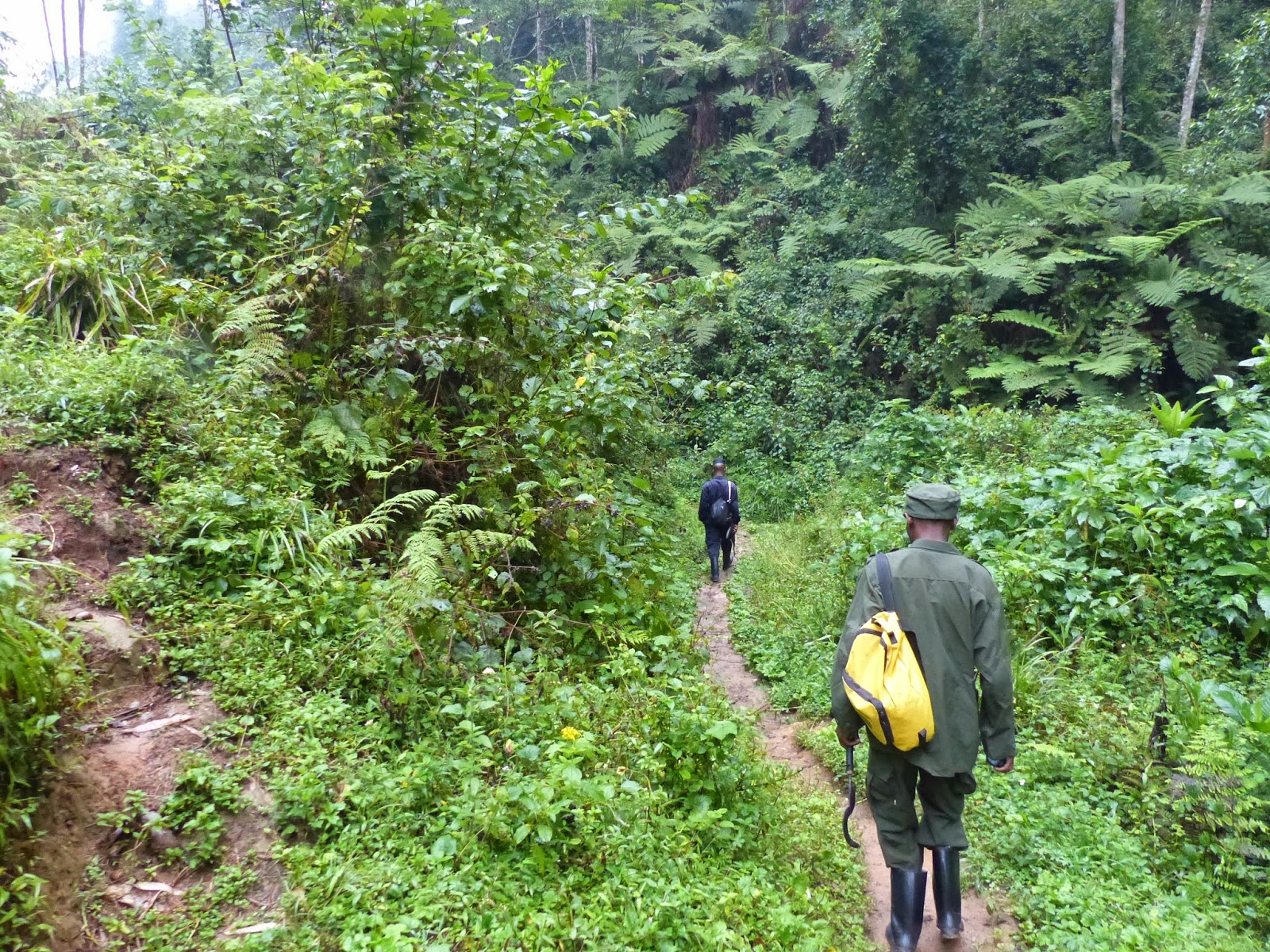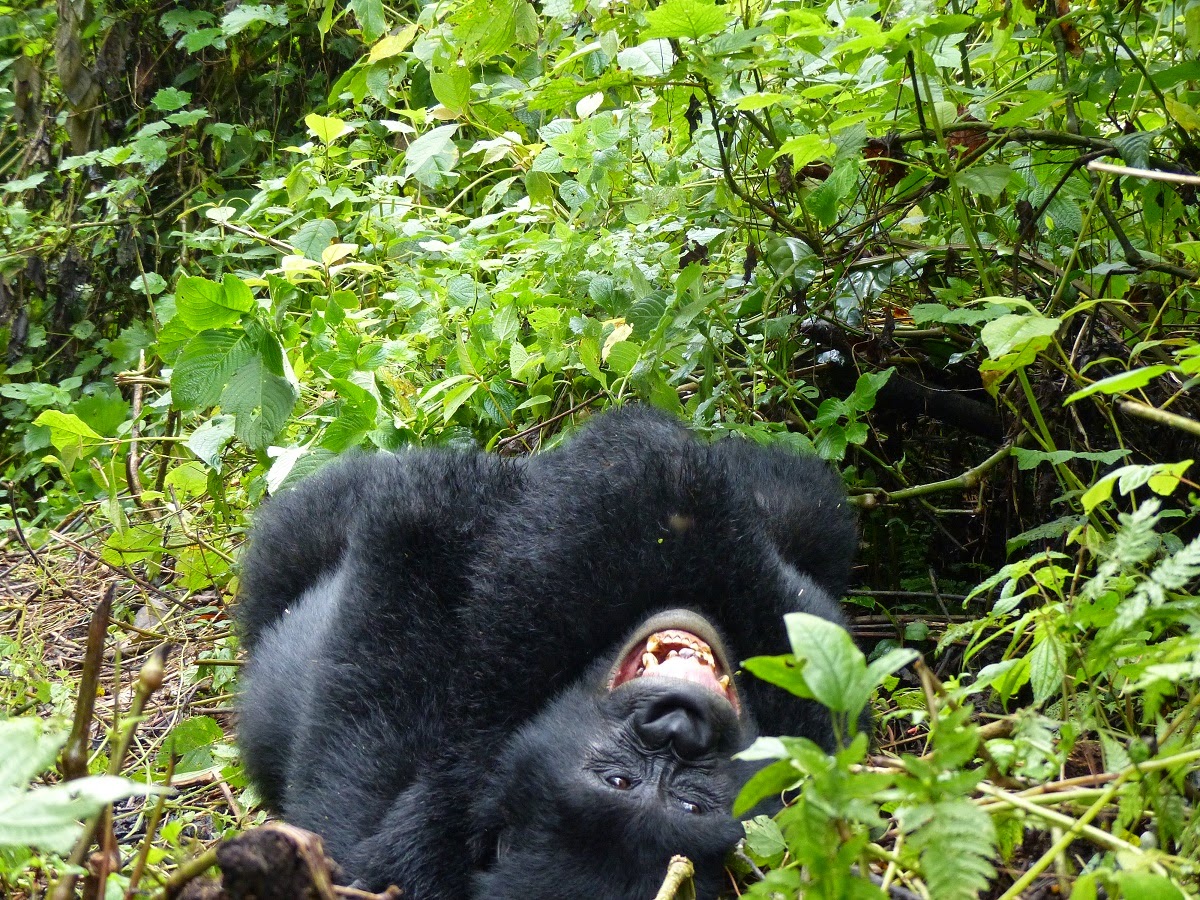It was the night before the gorilla treck. Most tourists get
driven to the National Park entry by a local guide, but I have my own transport
so Im going to drive myself. However the route from the nearby town where Im
staying to the Park entry is not exactly straight forward… So I get some
instructions and then go to bed early so I can get up early and complete the
drive. I need to be at the Park entry by 7:30am and its about 35Km away on
apparently not great road. So I get up at 5:45am in the morning, get all my
stuff packed and on the bike and set off at 6:00am. At that hour its still
pitch black here and it adds significantly to the challenge of finding the road
that Im looking for. I figure it out OK after asking questions of a couple of
locals who are also up at this hour and walking along the road side (presumably
heading to work?). Then the road gets a bit tricky and is pretty rocky and
definitely 4WD territory… And riding the big heavy bike over technical ground
is always interesting but doing it at nigh makes for added entertainment J No
worries, things could always be worse right?... Ten minutes later Ive stopped
riding so I can put on my wet weather gear because its now started raining
fairly solidly… yep we’ve got “full conditions”… The only missing thing is lots
of deep mud. Fortunately the mud does not appear (well only a couple of small
patches) and after another hour of riding along a very minor dirt road (that
actually improved as I went along rather than deteriorated) I got to the
appointed place J
After a bit of a wait for the other tourists to show up, we get a
bit of a chat about the park and the gorillas and how to behave and what to
expect. There are only two places in the world where the Mountain gorillas
live; One is here in “Bwindi Impenetrable Forrest Park” and the other is about
an hour away at “Virunga Park”. Bwindi is the larger Ugandan park though its
very small at only 330sqKm in size and it has about 400 gorillas (pretty high
density I think) while the other park is slightly smaller but straddles three
countries (DRC, Rwanda, and Uganda) and similarly has about 400 gorillas
(mostly on the Rwandan side of the park).
Then we are divided into groups (maximum size of 8 tourists) and
the groups all set off to see different family groups of gorillas. There are
five different groups of “habituated” gorillas at present which means that they
are used to humans being near them and view us as a “neutral” element in their
environment… It does not mean they are tame and it does not mean we get to “interact”
with them. It means we can be very near and watch them behaving more or less
normally, but it also means their fear of humans is minimized which actually
makes them very vulnerable to poachers and hunters etc. This is however
mitigated by the fact that there are human guards/trackers with the gorillas
pretty much all day every day, and the parks are small and well guarded and
maintained… And that’s because there are so many tourists coming to see them (5
groups of 8 tourists at $500 a piece is about $20,000 of income for the Park/government
every day!!)
And so my group sets off into the park headed for our allocated
gorilla family. We are accompanied by a guide and two “police/guards” with AK47
machine guns over their shoulders!... But the guns are not for bandits or the
other sorts of guerillas but rather they are for defense against elephants or
Buffalo if we run into any unexpectedly. No, not to actually shoot them but to
scare them off with very loud noise if necessary. My group of tourists is
mostly pretty healthy for which I am grateful since the terrain we are in is
exceedingly steep, slippery, and heavily vegetated. We are moving along a
pretty clear human trail but there are plenty of slips and slithers in the
tricky sections and since we could be in for a hike of up to 4-5 hours to get
to the gorillas it would be rather annoying to not see the gorillas because an
unfit person in the group cant keep moving! (Actually I believe the Park staff
take that kind of thing into consideration when the divide up the groups and
the less fit people tend to get gorilla families that are likely to be more
accessible).
As I said, the gorillas are tracked pretty much all day every day
but they are left alone over night and they can move in that time and it may
take a while to find them again. For our group, the trackers are out looking
for the gorillas but have not yet located them by the time we set off walking
so no one knows if they will be found near or far from where they were
yesterday? But, about 45min after we set off the guide informs us they have
been located and we will likely be there within the hour… we keep
hiking/climbing along the trail…
Actually the forest here is really quite dense and the hills are
exceedingly steep. It’s a tropical rain forest and it is rainy season, but its
also high up on the mountains so the temperatures are not “steamy” though there
are also no winds in the forest to help keep you cool through evaporation. The
result is that if you just sit around its quite cool and you would need warm
cloths to stay comfortable, But, if you are moving around then its hard work on
the steep slippery ground and you get very hot and sweaty very quickly.
The forest its self looks very familiar to me though… It reminds
me very much of the steep valley forests with lots of tall trees and huge
tree-ferns of SW Tasmania… Quite beautiful but very hard to move through if you
are not on a trail J
Then we come to a place where we head off the main trail and into
a lush green area without big trees… I figure the gorillas must be close… We
are moving very slowly now as the guide has to cut a trail through the thicket.
We meet the trackers and then after only another 30m of progress or so we come
across a gorilla just quietly sitting there munching away on the vegetation…

Wow, that is definitely a BIG black monkey J
For some reason or other I had it in my mind that the mountain
gorillas were smaller than the lowland gorillas but it is in fact the other way
around… These guys are the big ones. Initially there is not much of a view of
the gorillas because of the intervening herbage, but we slowly get closer and
can see better. Likewise, initially the gorillas seem to try to ignore us and
sit with their backs to us but after a while they let us get closer (to within
about 3m) and seem a bit more comfortable facing us.
The mountain gorillas are vegetarians and need to eat about 20Kg of food each day... Their pot bellies are a very prominent and natural anatomical feature :)
Thinking Gorilla
Again, such "human hands"
And then there are a couple more of them nearby and we move
carefully and slowly around as the gorillas move and eat etc. We are only allowed
to stay with the gorillas for about an hour so as not to interfere with the
gorillas life-style too much before we are required to head back. In that time
we got to see three big males and one female quite closely and we had a brief
view of a baby at close quarters and saw a couple more females of the family at
a distance of 100m or more. This family consisted of about 10 animals and the
senior “Silver-back” male was about 15 years old.
And after about 45min of working our way back along the trail (more
downhill than uphill) we were back where we started. I rode my bike back along
the little road that seemed far less daunting in the daylight, found a little
tourist café in town and had my-self a coffee and some lunch and took some
pain-killers for my aching feet and back!
Im not sure if the significant pain
is caused by an aging body in general or Ive just become incredibly unfit
though because I really didn’t think the three hours of hiking warranted the
amount of pain I felt!... Who knows? Not that it matters much anyway… The
discomfort and pain and money expended on the gorilla treck were I felt well
worth it at the end of the day… Though I must say I was not quite as “awe-struck”
by the experience as most tourists seem to be; perhaps because I had previously
done the Chimpanzee visit while I was in Tanzania?
























